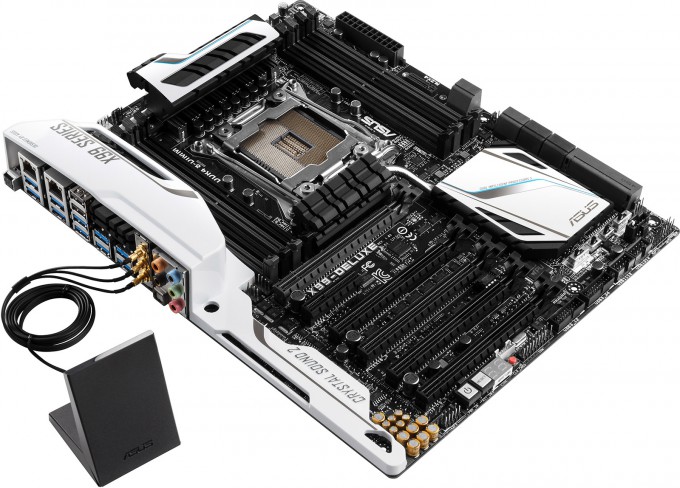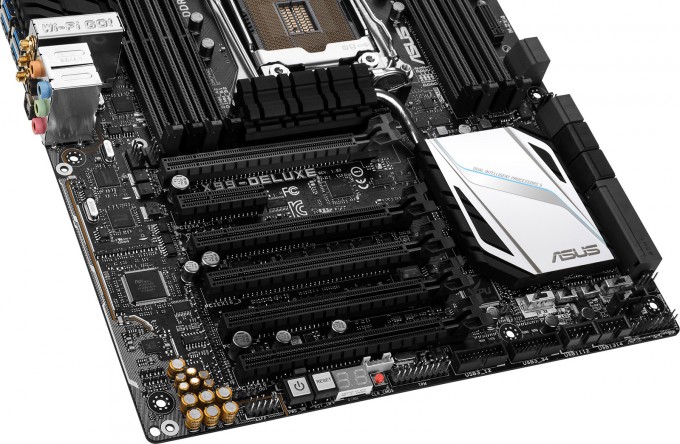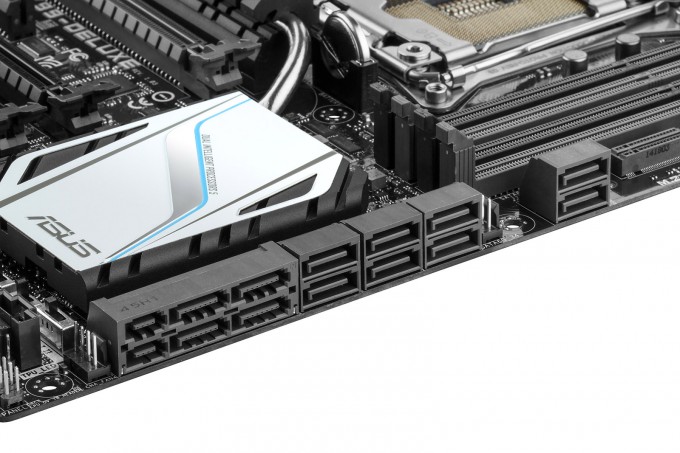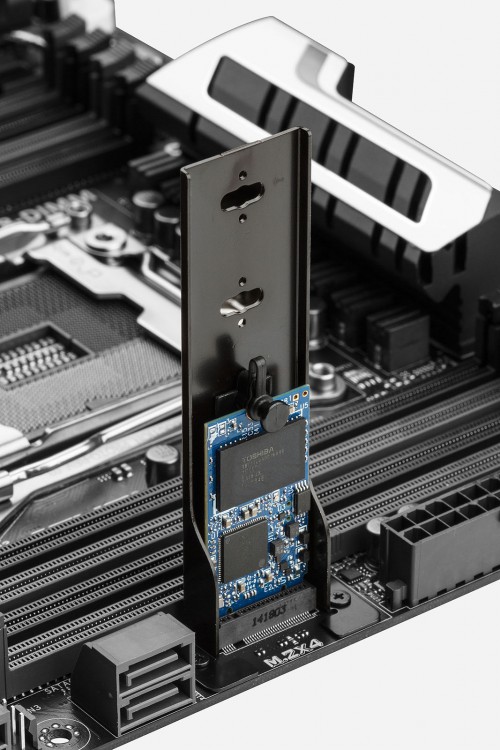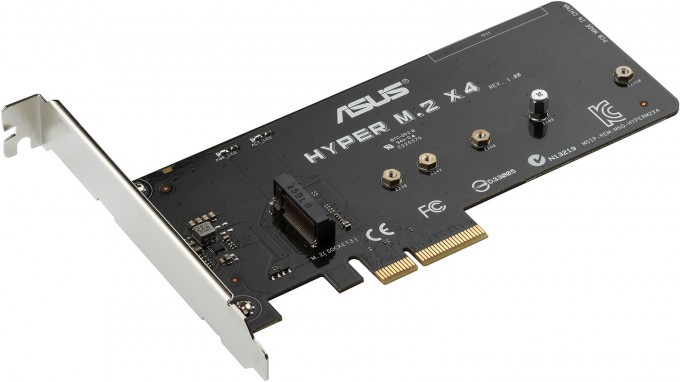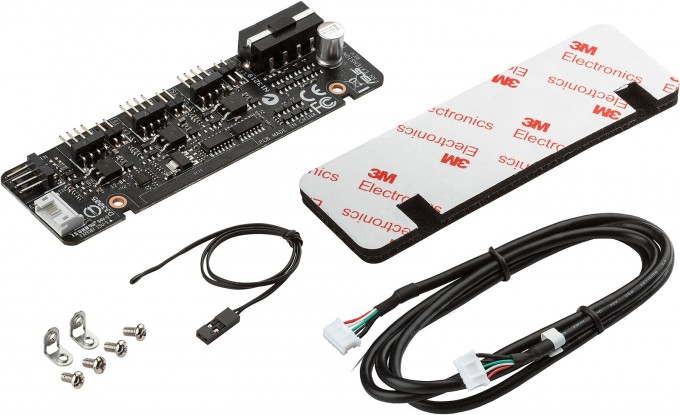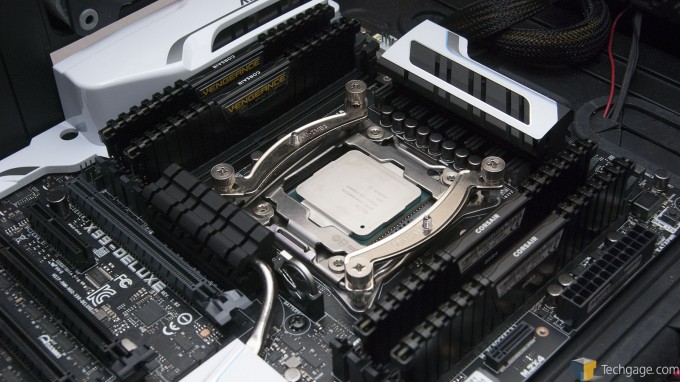- Qualcomm Launches Snapdragon 4 Gen 2 Mobile Platform
- AMD Launches Ryzen PRO 7000 Series Mobile & Desktop Platform
- Intel Launches Sleek Single-Slot Arc Pro A60 Workstation Graphics Card
- NVIDIA Announces Latest Ada Lovelace Additions: GeForce RTX 4060 Ti & RTX 4060
- Maxon Redshift With AMD Radeon GPU Rendering Support Now Available
ASUS X99-DELUXE Motherboard Review

The name “DELUXE” is often used on products that don’t quite deserve it, but when it comes to ASUS’ motherboards, the company makes sure that isn’t the case. Given that, it’s little suprise that the X99-DELUXE does in fact deserve its name, as it doesn’t just offer a slew of features and capabilities, it packs in extras we wouldn’t ever expect.
Page 1 – Introduction, A Tour Of The Hardware
ASUS’ goals for its DELUXE series of motherboards have never been hard to surmise. Outside of the usual “stable” and “overclockable”, “DELUXE” has long meant that a board is seriously feature-packed, and is designed to prevent people from ever running out of connectivity options.
That’s all true with ASUS’ X99-DELUXE, but given the sheer amount of features it bundles in, I almost feel like X99-ULTIMATE would have been a more appropriate name. With this board, everything you’d expect from a DELUXE board is present, but there are some surprises – including items you might not have realized you wanted.
ASUS’ X99-DELUXE launched alongside Intel’s Haswell-E processors in the fall, so I admit: I’m behind on getting this thing published. That’s something I regret, because the X99-DELUXE is a product I’ve been wanting to talk about for a while. Better late than never?
Based on the X99-DELUXE’s aesthetic alone, you can tell that this board means business. That’s something you can actually feel while holding it – it’s a heavy-duty board, without a doubt. Whether or not you like its styling is really dependant on your personal taste. I tend to prefer ASUS’ ROG aesthetics, but I do admit that I love it when vendors are not afraid to inject some white into their components.
It hardly needs to be reiterated, but the X99-DELUXE is packed to the gills with features and capabilities. We have 8 DIMM slots to deal with, allowing us to use up to 64GB of DDR4 memory, five full-sized PCIe slots, a staggering 12 USB ports at the back, dual Intel LAN, 802.11ac Wi-Fi, and up to 12 SATA ports (8 if two SATA Express drives are used). Yup – I think “packed” is an appropriate word.
| ASUS X99-DELUXE | |
| Architecture | Intel X99 (LGA2011-v3) |
| Form-Factor | ITX (12″ x 9.6″) |
| Memory | Up to 8x8GB DDR4-3200 |
| Multi-GPU | 4-way NVIDIA SLI 4-way AMD CrossFire |
| Expansion | 5x PCIe 3.0 x16 1x PCIe 2.0 x4 |
| Storage | 8x SATA 6Gbps (Intel) 1x SATA Express 6Gbps (Intel) 2x SATA 6Gbps (Intel; if SATA Express isn’t used.) 1x SATA Express 6Gbps (ASMedia) 2x SATA 6Gbps (ASMedia; if SATA Express isn’t used.) 1x M.2 (PCIe SSD: 2242/2260/2280) |
| Network | Intel I218V Gigabit Ethernet Intel I211-AT Gigabit Ethernet |
| Wireless | Wi-Fi 802.11 a/b/g/n/ac 2.4G/5G (Broadcom BCM4360) Bluetooth 4.0 |
| Audio | Realtek ALC1150 8-channel Optical S/PDIF out |
| USB | Back-panel: 2x 3.0 & 2x 2.0 (Intel), 8x 3.0 (ASMedia), Internal: 4x 3.0 & 4x 2.0 (Intel) |
| Back I/O | 2x 1Gbps LAN, 10x USB 3.0, 2x USB 2.0, 1x Optical S/PDIF, 5x Audio Jacks, Wi-Fi connector, BIOS Flashback button |
| Features | ASUS Dual Intelligent Processors 5, ASUS 5X Protection, ASUS TPU, ASUS EPU, ASUS Digital Power Design, ASUS Wi-Fi GO!, MemOK!, Ai Suite 3, ASUS EZ DIY, ASUS Q-Design, Fan Xpert 3 |
As seen in the table above, the X99-DELUXE features 5x PCIe x16 slots. However, the across-the-board slot speed will change depending on whether or not a 28-lane (i7-5820K) or 40-lane (i7-5930K & i7-5960X) processor is used:
- 40-lane: x16, x16/x16, x16/x16/x8, x8/x8/x16/x8, and x8/x8/x8/x8/x8
- 28-lane: x16, x16/x8, and x8/x8/x8
It doesn’t seem entirely likely that using two high-end GPUs with a 28-lane processor will affect the overall graphics performance, but it’s something to bear in mind. It’s unfortunate that Intel decided to throttle its i7-5820K in that way, but given what the CPU brings to the table for its price-point, I’d wager that that throttle is the best one Intel could have given us.
Nonetheless, the X99-DELUXE continues to cater to the high-end enthusiast with a plethora of storage options. Intel’s chipset provides a total of 10 SATA ports, although 2 can be utilized for SATA Express. The same applies to the ASMedia-supplied ports; you’ll have access to 2 more SATA ports should you forego SATA Express on that chipset.
The most notable storage option here is the x4 M.2 slot, which will allow you to use the fastest M.2 SSDs out there, such as Samsung’s XP941, which can peak at 1,000MB/s read and 930MB/s write.
For me personally, one of the better features of the X99-DELUXE is that it includes dual Intel LAN ports. It drives me a little bonkers when vendors that put two LAN ports on a board use a great chipset for one, and then a subpar one for the other. There’s none of that here. You can either use these ports independently, or aggregate them together for faster speeds (mostly useful for NAS boxes that also have the same capability).
Well, that sure was quite the span of words without images, wasn’t it? Let’s fix that by jumping right into the hardware tour.
Lining the bottom of the board are power / reset buttons, a BIOS code LED readout, clear CMOS button, TPM module connector, dual USB 3.0 internal headers, and dual USB 2.0 headers.
At the bottom left of the board is where the Realtek audio chipset is located, as well as its golden-colored capacitors nestled beside one of the board’s screw holes.
We can’t move on without talking about the PCIe configuration. As mentioned above, while there are 5x PCIe x16 slots here, your choice of CPU and number of add-in cards will decide its performance configuration.
It’s a little unfortunate that the board’s lone x4 PCIe slot is situated right beneath the main PCIe x16 slot. Should you want to use it, your graphics card will have to be single-slot. That’s all fine and good for those planning to go the water-cooling route, but that’s obviously a small number of people. Ideally, I think that slot should have been at the absolute bottom.
The X99-DELUXE has a total of 12 SATA ports. The 8 rightmost ones all draw from the Intel chipset; the reason two are split off is to simply give you a little more lenience with your cable routing. At the left are ports for two different SATA Express drives. Should you want to forego SATA Express (and I honestly couldn’t blame you, given M.2 is simpler), you can use those SATA ports for regular drives.
Towards the right side of the photo, and cut off slightly, is the board’s M.2 slot. To make best use of it, you’ll want to use an accessory that ASUS includes in the box, seen below, to make sure that once it’s installed, it’ll be secure.
If you’d rather install your M.2 SSD in a PCIe slot, you’re able to thanks to the inclusion of ASUS’ Hyper add-in card, seen below. It’s not a looker, but it’s what it can do that counts.
By offering us two different ways to use an M.2 SSD, it’s clear that ASUS would love for us to use one. With models that can go beyond 1GB/s read, it’s really no wonder why.
Earlier, I mentioned that this particular DELUXE board will include a couple of things you didn’t even realize you wanted, and in case it wasn’t obvious, the above M.2 expansion card was one of those. Another one can be seen below, a “Fan Extension Card” that does exactly what its name implies.
Where fan configurations are concerned, no motherboard can be perfect for everyone. While in one chassis, all fans might hook up to the board without a single issue, another might prevent one from reaching where it needs to. It’s with a scenario like that where this card can prove to be a blessing.
In order to work, this extension card requires a 4-pin Molex connector for power, and also a data cable (seen in the shot above) that connects to the board for the sake of internal control. With the included 3M padding, you can affix this mini-board anywhere in your PC, and instantly gain the ability to hook up 4 additional fans – that allows for a total of 10 fans that can be connected to the board directly.
Moving around back to the I/O port, we find a total of 10x USB 3.0 ports, 2x USB 2.0 ports, dual Intel Ethernet, a BIOS Flashback button, a full complement of audio ports, and also the board’s 802.11ac Wi-Fi card.
Because my personal photos of the X99-DELUXE couldn’t measure up to the great ones ASUS supplied me, I stuck with those. I will lift one photo from my review of Intel’s Core i7-5960X, though, as it’s pretty sexy. As you’d imagine, that’s the i7-5960X locked down into its socket (the mount is from a Noctua cooler), and there’s some Corsair Vengeance DDR4 gracing half of the DIMM slots.
With that exhaustive look at the hardware out-of-the-way, let’s move on towards a look at both the EFI and software package.
Support our efforts! With ad revenue at an all-time low for written websites, we're relying more than ever on reader support to help us continue putting so much effort into this type of content. You can support us by becoming a Patron, or by using our Amazon shopping affiliate links listed through our articles. Thanks for your support!




